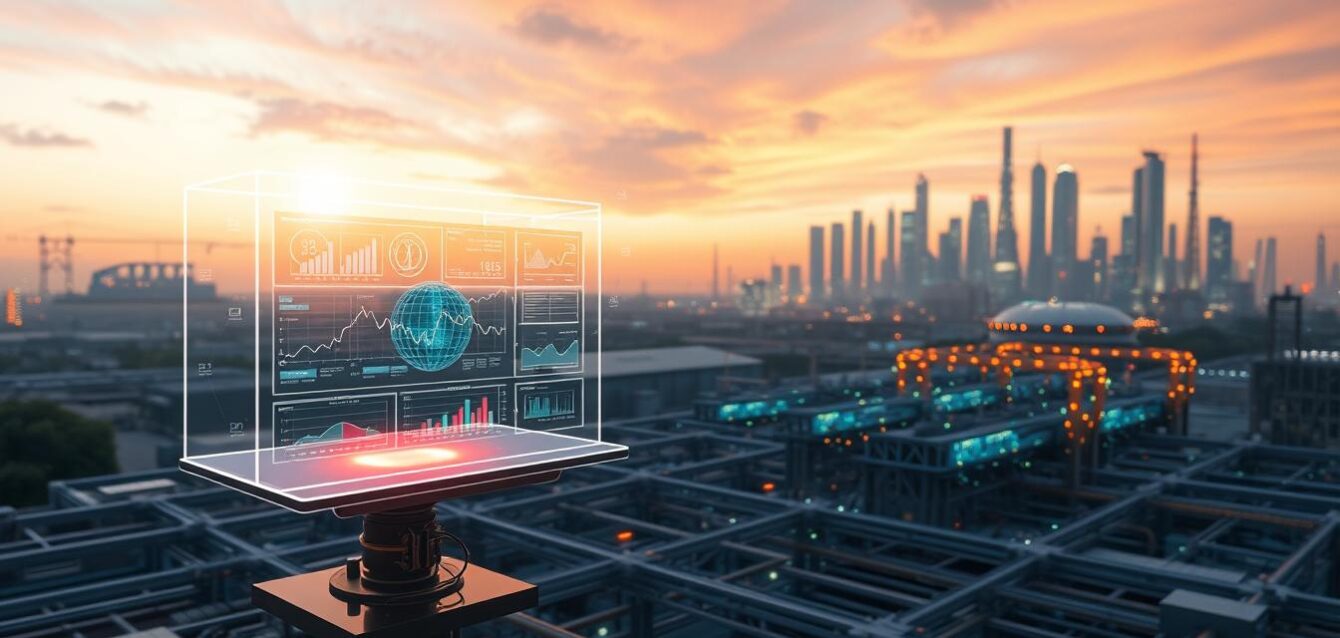Did you know that nearly 30% of industrial equipment fails due to unplanned maintenance issues? This leads to a lot of downtime and big financial losses. Digital twin monitoring is a key solution. It creates a dynamic, real-time virtual copy of physical assets, processes, and systems.
This technology uses IoT data and AI-driven analytics to find problems early and plan maintenance better. It helps keep critical machinery running smoothly, changing how we work.
Key Takeaways
- Digital twin technology provides a real-time virtual replica of physical assets.
- It leverages IoT data and AI-driven analytics for proactive maintenance.
- Predictive maintenance schedules are optimized for critical machinery.
- Operations are transformed through proactive anomaly detection.
- Significant reduction in unplanned downtime and financial losses.
Understanding Digital Twin Technology
At its core, digital twin technology creates a virtual copy of a physical asset. It allows for real-time monitoring and simulation. This tech is more than a 3D model; it’s a dynamic, connected replica that updates in real-time with data from its real-world counterpart.
Definition and Key Concepts
A digital twin is a virtual copy of a physical object, process, or system. It uses IoT, AI, cloud computing, and big data analytics. These technologies give a complete and up-to-date view of the physical asset, enabling predictive maintenance and data visualization.
The core of digital twin tech includes real-time data, advanced analytics, and machine learning. These tools simulate and predict the physical asset’s behavior. This helps organizations optimize performance, reduce downtime, and boost efficiency.
Historical Development
The idea of digital twins has been around for decades. But it became real with the rise of IoT and AI. The term “digital twin” was first used in 2002 by Michael Grieves. It has grown to be key in Industry 4.0.
The growth of digital twin tech is linked to better computing, data storage, and analytics. As these areas have advanced, so has the use and complexity of digital twins.
Current Trends in Technology
Now, digital twin tech is advancing with AI, machine learning, and edge computing. These advancements are making analytics more sophisticated and real-time. This boosts what digital twins can do.
Today, trends include using edge computing to cut down on latency and improve processing. Also, augmented reality is being used to improve how we see and interact with digital twins.
Benefits of Digital Twin Monitoring
Digital twin monitoring helps organizations run more efficiently and manage their assets better. It lets businesses optimize their operations, spot problems before they happen, and make smart choices with up-to-date data.
Enhanced Operational Efficiency
Digital twin monitoring makes operations smoother by creating a virtual copy of real assets. It allows for real-time monitoring and analysis. This means businesses can quickly find and fix problems, leading to better performance and less waste.
Predictive Maintenance Capabilities
Digital twin monitoring is great for predicting when equipment might fail. It uses data from sensors to forecast maintenance needs. This way, companies can plan maintenance ahead of time, cutting downtime and saving on costs.
Improved Decision-Making Processes
Digital twin monitoring helps make better decisions by giving accurate, up-to-date insights. It lets organizations try out different scenarios and see how they might play out. This leads to more informed choices, reducing the chance of expensive mistakes.
Using digital twin monitoring brings many benefits. It boosts operational efficiency, helps predict maintenance needs, and improves decision-making. This leads to cost savings, less downtime, and better safety, helping businesses succeed in the long run.
Applications of Digital Twin Monitoring
Digital twin monitoring is changing many fields, from making things to helping people stay healthy. It makes virtual copies of real things. This lets companies check how things work and guess how they will do. It makes things run better.
Manufacturing and Production
In making things, digital twin monitoring helps make production better. It helps manage products from start to finish and guess when things might break. Machine learning algorithms help by looking at data from sensors and machines. This lets companies make decisions fast.
| Industry | Application | Benefits |
|---|---|---|
| Manufacturing | Production line optimization | Increased efficiency, reduced downtime |
| Manufacturing | Predictive maintenance | Reduced maintenance costs, improved product quality |
| Manufacturing | Product lifecycle management | Enhanced product design, reduced time-to-market |
Smart Cities and Infrastructure
Digital twin monitoring is also used in smart cities. It helps manage buildings, traffic, and energy. Cities can try out different plans and see what works best.
Healthcare Innovations
In healthcare, digital twin monitoring is used to make models of patients. It helps predict how treatments will work and make healthcare better. This could change how we treat patients, making care more personal and effective.
Digital twin monitoring is changing many areas. It shows how technology can make things better. As tech gets better, we’ll see even more ways it can help us.
Implementation Strategies for Organizations
Creating a solid plan is key for companies wanting to use digital twin monitoring to boost their work. This means looking at what they already have, fitting it with what they already use, and teaching their team new skills.
Assessing Existing Infrastructure
The first thing to do is check out what your company has now. Look at the IoT sensors and how you collect data. Also, see what your IT setup can do. This helps find where you might need to do better.
Integrating with Current Systems
It’s important to make sure the new digital twin system works well with what you already have. This means it should talk to your ERP, CRM, and other systems smoothly. APIs and data integration platforms help make this happen, letting data move easily between systems.
Training and Skill Development
Getting your team ready for digital twin monitoring is a big job. They need to know how to use the tech and understand the data. This helps make the most of predictive maintenance.
It’s smart to create training that teaches about data analysis, IoT, and how to integrate systems. This way, your team can really use digital twin monitoring to its fullest.
Challenges and Future of Digital Twin Monitoring
As digital twin technology grows, it faces many challenges. One big issue is security and data privacy. Digital twins need real-time data and asset management to work well.
Addressing Security Concerns
Organizations must take strong steps to protect digital twins. They need to use data visualization tools and machine learning algorithms. These tools help spot and handle threats.
Overcoming Technical Limitations
There are also technical hurdles to clear. Issues like data integration and interoperability need to be solved. Using real-time analytics and advanced data management can help. This ensures digital twins work smoothly with current systems.
Emerging Trends and Future Forecasts
The future of digital twin monitoring looks bright. Trends like AI and autonomous operations will shape it. We’ll see more advanced digital twins that work better together and focus on sustainability.
FAQ
What is digital twin monitoring, and how does it work?
Digital twin monitoring creates a virtual copy of real assets. It uses IoT data and AI to help with maintenance and improvement. It combines IoT sensors, data visualization, and machine learning for real-time insights and better asset management.
What are the benefits of using digital twin monitoring in manufacturing?
Digital twin monitoring boosts efficiency and predictive maintenance in manufacturing. It helps in optimizing production and managing products throughout their life. This leads to cost savings, less downtime, and better safety.
How does digital twin monitoring improve asset management?
It offers real-time analytics and data visualization for better asset tracking. This helps predict failures and plan maintenance. It reduces downtime, improves safety, and boosts asset efficiency.
What are the key technologies that power digital twin monitoring?
Key technologies include IoT, AI, cloud computing, and machine learning. These enable dynamic replicas that receive real-time data. This supports predictive maintenance and data-driven decisions.
How can organizations implement digital twin strategies effectively?
Organizations should assess their infrastructure and integrate with current systems. Training personnel is also key. Addressing cybersecurity, fostering collaboration, and using IoT and predictive maintenance are essential for innovation and efficiency.
What are the challenges facing digital twin monitoring, and how can they be addressed?
Challenges include security, technical limitations, and the need for advanced analytics. Address these by strengthening cybersecurity, investing in analytics, and using machine learning for innovation and efficiency.
What are the emerging trends and future forecasts in digital twin monitoring?
Trends include AI, autonomous operations, and cognitive digital twins. Data visualization, real-time analytics, and asset management are becoming more important. These will drive innovation and efficiency in various sectors, like manufacturing and healthcare.




